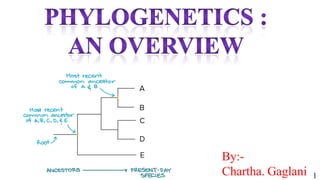
Phylogenetics an overview
- 2. CONTENTS 1. What is phylogenetics? 2. Why use molecular data? 3. Why is phylogenetics important? 4. Applications 5. What is phylogeny? 6. A true tree? 7. Evolutionary date and time are confounded 8. Alternative representation of phylogenesis 9. Major stages in phylogenetics analyses. 2
- 3. WHAT IS PHYLOGENETICS? • Phylogenetics is the study of evolutionary relationships among biological entities - often species, individuals or genes. • Typically phylogeneticists study one of the following types of question: • What are the evolutionary relationships or histories among any species/individuals/genes of interest? • How do sequences evolve? 3
- 4. • We can reconstruct a phylogenetic tree by looking at the nucleotide or protein sequences and combining this with our understanding of sequence evolution, which is described using an evolutionary model. • This enables us to infer evolutionary events that happened in the past, and also provides more information about the evolutionary processes operating on sequences. 4
- 5. 5
- 6. WHY USE MOLECULAR DATA? • Today almost all evolutionary relationships are inferred from molecular sequence data. This is because: • DNA is the inherited material; • We can now easily, quickly, inexpensively and reliably sequence genetic material; • Sequences are highly specific and are often information rich. 6
- 7. • In rare cases, where it is not possible to obtain genetic material (e.g. in the case of certain ancient fossil samples), morphological measurements can be used to infer evolutionary relationships. • However, this approach is less reliable than using molecular data because we know that sometimes the same morphological trait can arise from multiple independent evolutionary lineages (i.e. occurances of the trait are analogous). 7
- 8. WHY IS PHYLOGENETICS IMPORTANT? • Phylogenetics is important because it enriches our understanding of how genes, genomes, species (and molecular sequences more generally) evolve. • Through phylogenetics, we learn not only how the sequences came to be the way they are today, but also general principles that enable us to predict how they will change in the future. • This is not only of fundamental importance but also extremely useful for numerous applications. 8
- 9. 9
- 10. APPLICATIONS • Classification: Phylogenetics based on sequence data provides us with more accurate descriptions of patterns of relatedness than was available before the advent of molecular sequencing. Phylogenetics now informs the Linnaean classification of new species. • Forensics: Phylogenetics is used to assess DNA evidence presented in court cases to inform situations, e.g. where someone has committed a crime, when food is contaminated, or where the father of a child is unknown. • Identifying the origin of pathogens: Molecular sequencing technologies and phylogenetic approaches can be used to learn more about a new pathogen outbreak. This includes finding out about which species the pathogen is related to and subsequently the likely source of transmission. This can lead to new recommendations for public health policy. 10
- 11. • Conservation: Phylogenetics can help to inform conservation policy when conservation biologists have to make tough decisions about which species they try to prevent from becoming extinct. • Bioinformatics and computing: Many of the algorithms developed for phylogenetics have been used to develop software in other fields. 11
- 12. WHAT IS PHYLOGENY? • A phylogeny, also known as a tree, is an explanation of how sequences evolved, their genealogical relationships, and therefore how they came to be the way they are today. 12
- 13. 13
- 14. A TRUE TREE? • The case of a family tree is a rare example where we typically know part of the true biological tree; we have a complete explanation of the genealogical relationships among family members. This is because we know: • (i) all of the ancestors and descendants who are or were recently living; • (ii) the identities of the biological parents of each child. 14
- 15. • Unfortunately, when we estimate phylogenies from present day sequences that are not so closely related, we seldom know the true tree. • This is because we do not know what sequences occurred in the ancestors, and therefore what genetic changes occurred to make the sequences the way they are today. • This is why we need methods of phylogenetic reconstruction to infer the true tree. 15
- 16. 16
- 17. EVOLUTIONARY DATE AND TIME ARE CONFOUNDED • The genetic change is calculated by a combination of the rate of substitution and the time that has elapsed, as shown in the equation below: • Genetic change= Evolutionary rate x Divergence time (substitution/ (substitutions/ (years) rate) site/ year) 17
- 18. • This makes it very important for you to consider the biological information and context that you know about when interpreting trees. • If you are lucky enough to know the dates when your samples were isolated, then there are some methods available that can help you to disentangle these processes. 18
- 19. 19
- 20. ALTERNATIVE REPRESENTATION OF PHYLOGENESIS • Diagonal and rectangular formats are most commonly used for publication. • Rectangular format has the advantage that it is easy for the human eye to quickly assess the relative branch lengths; however you should note that the length of the lines that are perpendicular to the branch lengths have no meaning. 20
- 21. • Curved format is often used in review papers to represent summaries of phylogenies, where precise knowledge of branch lengths may be less important. • Radial format is typically used to show unrooted trees, and circular format is often used to represent large phylogenies with many taxa (for the simple reason that it is easy to fit onto a printed page). 21
- 22. MAJOR STAGES IN PHYLOGENETICS ANALYSES • There is no recipe available to complete a phylogenetic analysis as the approaches that you take are highly context and situation specific, and ultimately depend upon your biological question of interest. 22
- 23. 23
- 24. THANK YOU.. 24